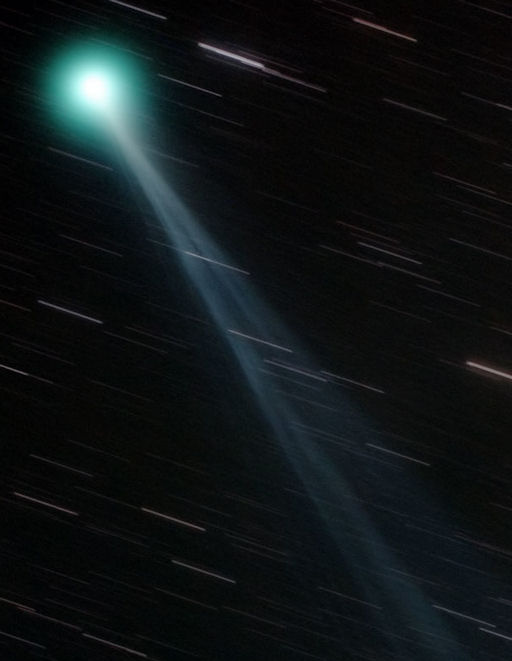CHANCE OF FLARES: New sunspot AR1678 has developed a delta-class magnetic field that harbors energy for strong explosions. NOAA forecasters estimate a 45% chance of M-flares and a 15% chance of X-flares during the next 24 hours. Solar flare alerts: text, voice.
AURORA WATCH: Despite mostly-low solar activity, February has been a good month for auroras, with some observers reporting weeks of nightly Northern Lights around the Arctic Circle. "There were great auroras yesterday night outside the little Inuit village of Ivujivik in Nunavik, Quebec," says Sylvain Serre, who photographed some of the onlookers:
Serre used a Canon EOS 5D digital camera set to 4000 ISO for the 3.2 second exposure. Other photographers should take note of those settings because more lights are in the offing. NOAA forecasters estimate a 25% chance of polar geomagnetic storms on Feb. 21 as a solar wind stream approaches our planet. Aurora alerts: text, voice.
A GREEN LEMMON: At the moment there are three significant comets plunging toward the sun: Comet ISON, Comet Pan-STARRS, and Comet Lemmon. The most beautiful so far is this one:
"Comet Lemmon has a beautiful tail with lovely fine structure," says Phil Hart of Lake Eppalock, Victoria, Australia, who photographed it on Feb. 17th.
The comet is now slightly closer to the sun than Earth. Solar heating has turned it into a binocular object (magnitude +5.5 to +6) barely visible to the human eye, but dazzling through backyard telescopes, as shown in Hart's photo above.
Comet Lemmon's verdant color comes from two of the gases boiling off its nucleus: cyanogen (CN: a poisonous gas found in many comets) and diatomic carbon (C2). Both substances glow green when illuminated by sunlight in the near-vacuum of space.
The combination of its colorful atmosphere and filamentary tail make this comet visually striking. Ultimately, Comet Pan-STARRS and especially Comet ISON could surpass it, but for now the most beautiful comet in the solar system appears to be a green Lemmon. More about Comet Lemmon: 3D orbit, ephemeris, light curves.

![]()
Solar wind
speed: 401.5 km/sec
density: 2.7 protons/cm3
explanation | more data
Updated: Today at 2127 UT
![]()
X-ray Solar Flares
6-hr max: B5 1753 UT Feb21
24-hr: C2 0505 UT Feb21
explanation | more data
Updated: Today at: 2056 UT
![]()
![]()
![]()
Daily Sun: 21 Feb 13
![]()
![]()
Sunspot AR1678 poses a threat for X-class flares. Credit: SDO/HMI
![]()
![]()
![]()
Sunspot number: 106
What is the sunspot number?
Updated 21 Feb 2013
Spotless Days
Current Stretch: 0 days
2013 total: 0 days (0%)
2012 total: 0 days (0%)
2011 total: 2 days (<1%)
2010 total: 51 days (14%)
2009 total: 260 days (71%)
Since 2004: 821 days
Typical Solar Min: 486 days
Update 21 Feb 2013
The Radio Sun
10.7 cm flux: 114 sfu
explanation | more data
Updated 21 Feb 2013
![]()
![]()
![]()
Current Auroral Oval:
![]()
Switch to: Europe, USA, New Zealand, Antarctica
Credit: NOAA/POES
![]()
![]()
![]()
Planetary K-index
Now: Kp= 2 quiet
24-hr max: Kp= 2 quiet
explanation | more data
![]()
Interplanetary Mag. Field
Btotal: 5.9 nT
Bz: 0.8 nT north
explanation | more data
Updated: Today at 2127 UT
![]()
![]()
![]()
Coronal Holes: 20 Feb 13
![]()
![]()
Solar wind flowing from this sinuous coronal hole could reach Earth on Feb. 21-22. Credit: SDO/AIA.






